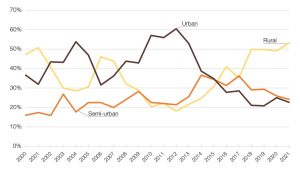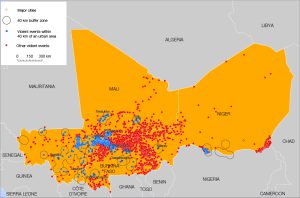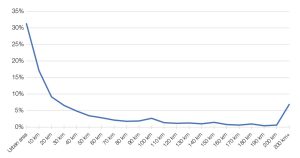By Steven M. Radil, U.S. Air Force Academy, Olivier Walther, University of Florida, Nicholas Dorward, University of Bristol, Matthew Pflaum, University of Florida and Marie Trémolières, The Sahel and West Africa Club/OECD
26 July 2022

Political violence is moving away from cities in North and West Africa, even as urban populations continue to grow at an unprecedented pace in the region. More than half of the violent events observed in 2021 took place in rural areas, against 20% a decade ago. The emergence of Jihadist insurgencies in the Sahel and its southern peripheries explains this ruralisation of conflict that affects a growing number of civilians and border regions.
More conflict in rural areas
Cities have long been considered the principal locus for warfare, insurgency and politically motivated violence. Yet, increased urbanisation in North and West Africa has not led to a corresponding increase in conflict in urban areas across the region. Building on previous work addressing the geography of conflict by the OECD Sahel and West Africa Club, our study is the first to reveal that battles, explosions, and violence against civilians increasingly take place in rural areas, far away from capital cities and regional centres.
Combining population data from WorldPop and conflict data from ACLED for 21 countries over 22 years shows that, since a peak of 60% of all events in 2012, urban violence has decreased sharply to just under 21% in 2019. In 2021, events in urban and semi-urban areas each accounted for 23% of the total, while 53% of events (and 56% of fatalities) occurred in rural areas in the same year (Figure 1).
The ruralisation of conflict has been particularly spectacular in the West African Sahel, although Jihadist organisations have maintained a complex relationship with cities. On the one hand, cities provide ideal conditions for Jihadist organisations to flourish due to their large population of unemployed youth. In northern Nigeria, for example, the first members of the Boko Haram sect were radical youth from Maiduguri, many of them from the social upper class.
Figure 1. Violent events by area in North and West Africa, 2000-2021

Source: authors based on ACLED (2022) and WorldPop (2022) data.
On the other hand, controlling cities has become less important for Jihadist groups than in the early years of the insurgencies. Since the violence affecting West Africa has largely shifted from the Sahara to the Sahel and its southern margins, these groups do not have to physically control cities to influence civilians and have access to natural, mineral and agricultural resources. In the Inner Niger Delta, for example, they impose embargoes on rural communities that refuse to let them rule, and they threaten to kill traders, politicians and civil society leaders who live in cities but own property in rural areas. Through this strategy of intimidation, violent groups have gained control over large expanses of rural areas, imposing local taxes on trade and stealing cattle on a large scale.
Figure 2. Violent events and urban areas in the Central Sahel, 2020-2021

Source: authors based on ACLED (2022) and WorldPop (2022) data.
Violence decreases with distance from cities
The fact that the violence in North and West Africa increasingly occurs in rural areas doesn’t mean that violence is not spatially associated with urban areas. Much of the violence observed in the Sahel has been associated with smaller cities, including several near international borders, such as in the tri-national region between Burkina Faso, Mali and Niger (Figure 2). These results contrast with the recent evolution of the highly urbanised states of North Africa, where urban violence is more common overall.
While only 31% of all violent events occurred in urban areas, nearly 50% were observed within just 10 km of an urban area, and 69% occurred within 40 km. This relationship exhibits a classic distance-decay effect: the further away from an urban area, the fewer violent events are observed (Figure 3).
Figure 3. Violent events by distance from urban areas in North and West Africa, 2000-2021

Source: authors based on ACLED (2022) and WorldPop (2022) data.
This relationship is not a surprise given the importance of North and West African cities as sites of state authority, economic activity, religious education, and political control and contestation. However, the clarity of the relationship within the region and across multiple decades should not be mistaken for an immutable “law” of political geography. For example, civil conflicts in Libya, Nigeria and Sierra Leone have been consistently highly urbanised, while recent strife in Burkina Faso, Mali and Niger has been far less so.
Shifting patterns of violence
Our exploratory analysis of the relationship between political violence and cities reveals that the patterns of violence are rapidly shifting across the region, as conflict ebbs and flows. Now that violence has diminished in the Gulf of Guinea and North Africa but emerged in the still largely rural central Sahel, the overall locational trends in violence have shifted from urban to rural.
However, the political processes behind the spatial and temporal patterning of violence within the region remain anchored in the efforts of states to realise and manage sovereignty within their own borders and in the actions of various groups that seek to challenge, supplant, or somehow reconfigure the state. Given the importance of cities to this process, urban areas will remain important focal points for place-based policies that attempt to address the root causes of political violence in the region.
Email: steven.radil@afacademy.af.edu
Learn more:
- Urban-rural geographies of political violence in North and West Africa
- Borders and Conflicts in North and West Africa
- Africa’s Urbanisation Dynamics 2022
Disclaimer: The views expressed in this manuscript are those of the authors and do not necessarily reflect the official policy or position of the United States Air Force Academy, the Air Force, the Department of Defense, or the U.S. Government.
Photo: Shutterstock

